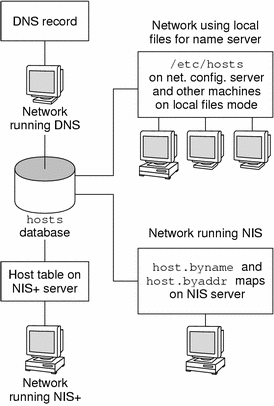How Name Services Affect Network Databases
The form of your network database depends on the type of name service you select for your network. For example, the hosts database contains, at minimum, the host name and IPv4 address of the local machine and any network interfaces that are directly connected to the local machine. However, the hosts database could contain other IPv4 addresses and host names, depending on the type of name service on your network.
The network databases are used as follows:
-
Networks that use local files for their name service rely on files in the /etc/inet and /etc directories.
Note –
DNS boot and data files do not correspond directly to the network databases.
The following figure shows the forms of the hosts database that is used by these name services.
Figure 5–2 Forms of the hosts Database Used by Name Services

The following table lists the network databases and how they are used by local files, NIS+, and NIS.
Table 5–1 Network Databases and Corresponding Name Service Files|
Network Database |
Local Files |
NIS+ Tables |
NIS Maps |
|---|---|---|---|
|
/etc/inet/hosts |
hosts.org_dir |
hosts.byaddr hosts.byname |
|
|
ipnodes |
/etc/inet/ipnodes |
ipnodes.org_dir |
ipnodes.byaddr ipnodes.byname |
|
/etc/inet/netmasks |
netmasks.org_dir |
netmasks.byaddr |
|
|
/etc/ethers |
ethers.org_dir |
ethers.byname ethers.byaddr |
|
|
/etc/bootparams |
bootparams.org_dir |
bootparams |
|
|
/etc/inet/protocols |
protocols.org_dir |
protocols.byname protocols.bynumber |
|
|
/etc/inet/services |
services.org_dir |
services.byname |
|
|
/etc/inet/networks |
networks.org_dir |
networks.byaddr networks.byname |
This book discusses network databases as viewed by networks that use local files for name services. Information about the hosts database is in hosts Database. Information about the ipnodes database is in /etc/inet/ipnodes File. Information about the netmasks database is in netmasks Database. Refer to System Administration Guide: Naming and Directory Services (DNS, NIS, and LDAP) and System Administration Guide: Naming and Directory Services (FNS and NIS+) for information on network databases correspondences in NIS, NIS+, DNS, and LDAP.
- © 2010, Oracle Corporation and/or its affiliates
